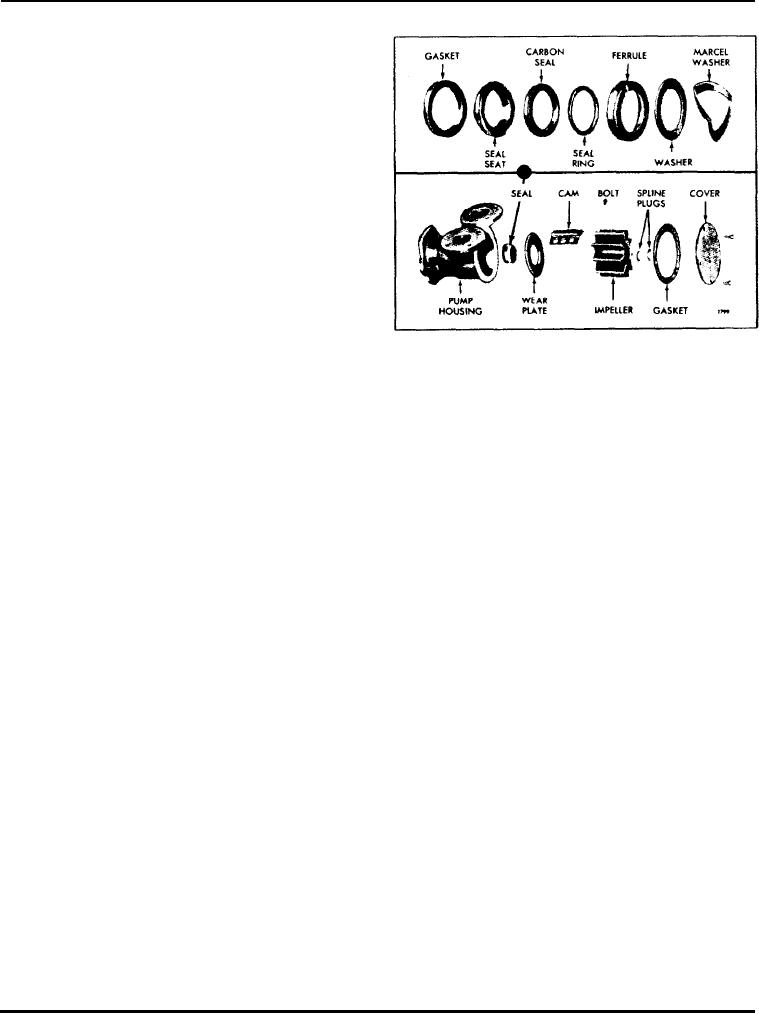
Engine Systems
The radiator is reverse-flushed as follows:
1. Remove the radiator inlet and outlet hoses and
replace the radiator cap.
2. Attach a hose at the top of the radiator to lead
water away from the engine.
3. Attach a hose to the bottom of the radiator and
insert a flushing gun in the hose.
4. Connect the water hose of the gun to the water
outlet and the air hose to the compressed air outlet.
5. Turn on the water and, when the radiator is full,
turn on the air in short blasts, allowing the radiator to
fill between air blasts.
CAUTION: Apply air gradually. Do not exert
more than 30 psi (207 kPa) air pressure. Too
Fig. 20 - Raw Water Pump Details and
great a pressure may rupture a radiator tube.
Relative Location of Parts
6. Continue flushing until only clean water is expelled
When water connection seals and hoses are installed,
from the radiator.
be sure the connecting parts are properly aligned and
the seal or hose is in its proper position before
The cylinder block and cylinder head water passages
tightening the clamps. All external leaks should be
are reverse-flushed as follows:
corrected as soon as detected.
1. Remove the thermostat and the water pump.
The fan belt must be checked and adjusted, if
2. Attach a hose to the water inlet of the cylinder block
necessary, to provide the proper tension and the fan
to drain the water away from the engine.
shroud must be tight against the radiator core to
prevent re-circulation of air which may lower the
3. Attach a hose to the water outlet at the top of the
cooling efficiency.
cylinder block and insert the flushing gun in the hose.
4. Turn on the water and, when the water jackets are
filled. turn on the air in short blasts, allowing the
Water Pump
engine to fill with water between air blasts.
The centrifugal type water pump is mounted on the
5. Continue flushing until the water from the engine
runs clean.
engine front cover and is driven by a front camshaft
gear. This pump circulates the engine coolant through
If scale deposits in the radiator cannot be removed by
the cylinder block, cylinder head, heat exchanger or
chemical cleaners or reverse-flushing as outlined
radiator and the oil cooler.
above, it may be necessary to remove the upper tank
and rod out the individual radiator tubes with flat steel
The pump consists of a bronze impeller secured to a
rods. Circulate water through the radiator core from
stainless steel shaft with a lock nut. A gear is pressed
the bottom to the top during this operation.
on the opposite end of the shaft and the shaft turns on
two ball bearings. An oil seal is used ahead of the
front bearing and a spring-loaded face type water seal
Miscellaneous Cooling System Checks
is used in back of the impeller. The pump ball
In addition to the above cleaning procedures, the other
bearings are lubricated with oil splashed by the water
components of the cooling system should be checked
pump gear.
periodically to keep the engine operating at peak
efficiency. The cooling system hoses, thermostats and
Contact an authorized Detroit Diesel Allison Service
radiator pressure cap should be checked and replaced
Outlet if more information is needed.
if found to be defective.
Page 29

